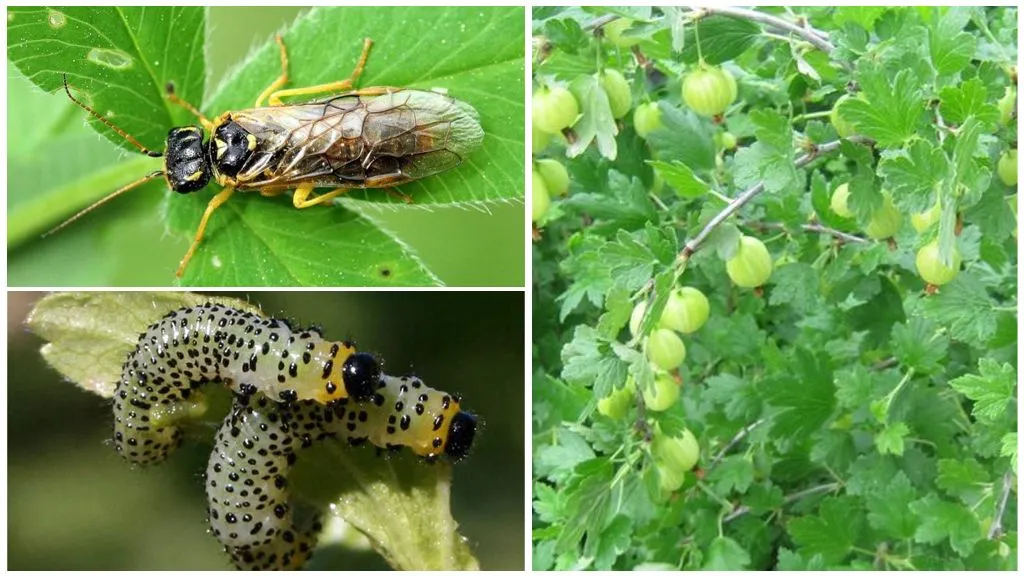The sawfly — the most destructive insect — can reduce the yield of gooseberries and currants by up to 95%. The pale-footed and yellow gooseberry sawflies pose the greatest threat. If you notice the first signs of their activity, immediate action is essential. Learn how to combat sawflies on gooseberries in this article.
Table of contents
Signs of Sawfly Infestation on Gooseberries
The larvae of the yellow and pale-footed sawflies cause the most damage. They rapidly devour leaves, leaving only the veins behind.
The second, third, and fourth generations are particularly dangerous due to their voracious appetite.
How to Identify the Pest

Adult yellow sawflies are reddish-yellow, while pale-footed sawflies are black with light spots on their bodies and legs. These insects measure no more than 8 mm in length. Their larvae, known as false caterpillars, have 10 pairs of legs and grow up to 1–1.8 cm long.
Females lay eggs on the underside of leaves, making spring inspections crucial for spotting clusters of eggs.
The first spring generation lives for 20–25 days, during which they consume half of the bush’s foliage before dropping to the ground to pupate.
The second generation becomes active during flowering, while the third and fourth emerge during fruiting.
Damage Caused
The extent of damage depends on the generation. The first brood often goes unnoticed, feeding on young leaves before giving rise to the next wave of pests.
The second generation attacks currants before moving to gooseberries, stripping bushes bare in 1–2 weeks. This weakens the plants, stunts growth, and reduces cold resistance.
The third and fourth generations continue ravaging gooseberries, resulting in small, prematurely dropped berries. Productivity declines, and future harvests fail to mature.
Note. Weakened gooseberries become susceptible to diseases like powdery mildew, scab, septoria, anthracnose, rust, and gray mold. Combined with pest damage, these infections can destroy entire plantings.
Causes of Infestation
Primary factors include drought, warm autumns, and the insects’ preference for herbaceous plants. Human negligence plays a minor role, as sawflies migrate and reproduce rapidly. The larvae thrive in any conditions, consuming crops indiscriminately.
Sawflies are attracted to the alkaloids in gooseberry, red currant, and black currant leaves. Gardeners must eliminate infestations and implement preventive measures.
Methods to Eliminate Sawflies on Gooseberries
Eradicating sawflies is challenging, especially in summer. While small spring populations are manageable, later generations require more intensive efforts.
Solutions include chemical treatments, organic remedies, agrotechnical practices, and mechanical removal.
Chemical Treatments
Use these only in severe cases, avoiding application during flowering and fruiting to protect pollinators and prevent berry contamination.
Popular European-approved products and usage instructions:
- Mospilan. A contact and systemic insecticide. Sold in 2.5 g sachets for small gardens. Dissolve one sachet in 10 L of water and spray plants, using 1–1.5 L per bush. Apply within 6 hours of mixing. Limit treatments to 1–2 per season: before flowering and after harvest.
- Calypso. A broad-spectrum insecticide. Available in 2 mL capsules. Mix 1 mL with 1 L of water, then dilute to 10 L. Spray leaves thoroughly, using 0.3–0.5 L per bush. Rotate with other insecticides to prevent resistance. Apply once — either pre-flowering or post-harvest.
- Decis ProTech. Comes in 5 mL ampoules. Dilute 5 mL in 10 L of water and use within 4 hours. Apply 2 L per bush, with two treatments spaced 14 days apart (pre-flowering or post-fruiting).
Wear protective gear when handling chemicals. Spray early morning or evening, ensuring no rain is forecast for 8 hours.
Organic Remedies
Safe for all growth stages, these methods also nourish plants with potassium, phosphorus, and trace elements.
Effective organic solutions:
- Chamomile infusion: Steep 1 kg of chopped chamomile in hot water for 10–12 hours. Strain, dilute half the concentrate in 5 L of water, and add grated soap. Spray bushes thoroughly.
- Wormwood infusion: Soak 1.2 kg of wormwood in 10 L of water for 3 days. Strain, add 70 g of baking soda, and apply to foliage.
- Pine-needle extract: Soak 2 kg of pine branches in 10 L of water for 6–8 days. Strain, dilute 1:3 with water, and spray bushes, covering both leaf sides.
Repeat treatments every 7–10 days. Adding 1–2 cups of wood ash boosts efficacy. Reapply after rain.
Agrotechnical Practices
Key recommendations:
- Inspect bushes regularly for webbing, discoloration, or curled leaves.
- Collect and burn fallen debris to prevent larval hatching.
- Water at the base only. Refresh mulch every 2–3 weeks.
- Prune old, damaged, or dry branches.
- Avoid overcrowding — it facilitates pest spread.
- Plant repellent companions: oregano, garlic, mustard, or chives.
Mechanical Removal
Shake branches over a white cloth to dislodge larvae, which curl up and drop. Gather and burn the cloth with the pests.
Seasonal Control Strategies
Expert guidelines:
- Use chemicals during dormancy.
- Opt for organic or mechanical methods during flowering/fruiting.
- Reapply chemicals post-harvest.
- Handpick and burn larvae-infested berries during fruiting, then treat with organic solutions.
Sawfly-Resistant Gooseberry Varieties
Breeders have developed resilient cultivars:
- Early-season: Invicta, Pax, Hinnomäki Yellow
- Mid-season: Captivator, Rokula, Martlet
- Late-season: Mucurines, Reflamba, Remarka
Even resistant varieties require proper care — neglect invites infestations.
Preventive Measures
Reduce infestation risks with these steps:
- In late October, collect and burn plant debris. Loosen soil; replace the top 10 cm if infestations were severe.
- Cover the root zone with black landscape fabric to block surviving larvae.
- In early spring, drench soil with boiling water to kill overwintering pests.
- Prune unhealthy branches and seal cuts with wood ash.
- Weed and mulch regularly with straw or compost.
Expert Tips and Common Mistakes
Avoid planting gooseberries where currants grew previously — they share pests and diseases. Choose resistant varieties, prioritize prevention, and combine methods. Treat nearby currants simultaneously. Use chemicals only pre-flowering or post-harvest.
Conclusion
Sawflies are among the most destructive gooseberry pests. Preventive measures are key, but chemical and organic treatments can curb active infestations.